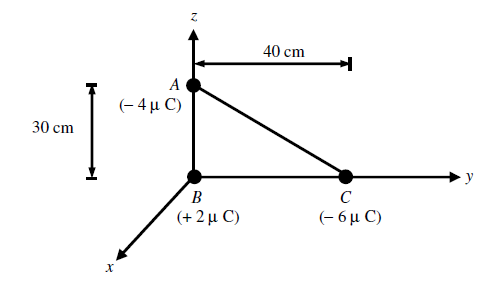Reference no: EM1310967
Question 1: a) Determine the magnitude and direction of the electrostatic force acting on particle A in the figure given below due to particles B and C. The values of the charge on these particles are indicated in the figure.

Express your result in the unit vector notation.
b) The line density of charge in a wire is 0.20 Cm−1. If this wire is symmetrically enclosed along its length by a cylindrical surface of radius 1.0 m and length 1.5 m, calculate (i) the electric flux through the cylindrical surface; and (ii) the electric field at the curved surface of the cylinder.
c) Two concentric metallic spheres having radii 30 cm and 20 cm carry 10μC and 5.0 μC charges, respectively. Calculate the electric potential at a distance of 25 cm from the centre of the spheres.
d) The value of the electric field just outside the surface of a negatively charged spherical conductor of radius 0.20 m is 0.042 NC-1, Calculate the number of electrons on the conductor.
Question 2. a) Explain the behaviour of a dielectric in an electric field. Deduce Gauss’s law for a dielectric medium.
b) Derive an expression for the capacitance of a cylindrical coaxial cable of length L. Assume that the length L of the cable is very large compared to its radius and there is vacuum between the wire and the cylinder of the cable. A capacitor of capacitance 2μF is charged to a voltage of 100 V. How much charge accumulates on the capacitor?
c) What do you understand by local field in a dielectric and how is it related to polarization.
Question: 3
3. a) Derive an expression for current density in terms of drift velocity of electrons in a metal.
Explain the conditions under which metals do not obey Ohm’s law.
b) In Bohr model, hydrogen atom consists of a negatively charged electron moves in a circular orbit around a proton at the nucleus. The motion of the electron constitutes an electric current. Calculate the magnetic field produced by the orbiting electron at the location of the nucleus if radius of the electron orbit is 5.29X10-11 m and electrons
orbital speed is 2.19X106 ms-1
c) State Ampere’s law. Using this law, obtain an expression for the magnetic field due to a long straight current-carrying wire.
d) Draw B-H curve for a ferro-magnet. Discuss how is it obtained and what is its importance.
Question: 4:
a) Explain why Maxwell modified Ampere’s law. Discuss the significance of Maxwell’s equations.
b) A uniform electromagnetic plane wave of 100 kHz travelling in free space strikes a large block of a material having ξ= 4 ξ0, μ = 9 μ0 and σ = 0
normal to the surface. The incident magnetic field vector is given by

Write the complete expressions for the incident, reflected and transmitted field vectors.